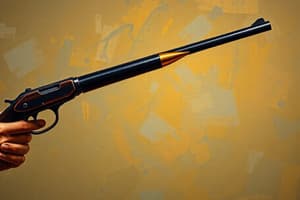Podcast
Questions and Answers
What are the three components of ballistics, and what does each component study?
What are the three components of ballistics, and what does each component study?
Internal ballistics studies what happens inside the firearm, external ballistics studies what happens during the bullet's flight, and terminal ballistics studies what happens when the projectile strikes the target.
What are the two types of guns, and what is the difference between them?
What are the two types of guns, and what is the difference between them?
Guns can be smooth bore or rifled bore. Smooth bore guns have a smooth inner surface, while rifled bore guns have spiral grooves cut into their inner surface to give the bullet spin.
What factors affect external ballistics?
What factors affect external ballistics?
Factors affecting external ballistics include the type of ammunition, barrel, and propellant charge for internal ballistics, and tangent elevation, muzzle angle, muzzle velocity, spin, and meteorological conditions for external ballistics.
Which of the following is NOT a factor affecting external ballistics?
Which of the following is NOT a factor affecting external ballistics?
What is the difference between bore caliber and saboted projectiles?
What is the difference between bore caliber and saboted projectiles?
What is the firing cycle of a firearm?
What is the firing cycle of a firearm?
Flashcards are hidden until you start studying
Study Notes
Introduction to Ballistics
- Ballistics is the study of the flight characteristics and dynamics of projectiles, from the moment it is fired to the moment it hits the target.
- Internal ballistics is the study of what happens inside the firearm, external ballistics is the study of what happens during the bullet's flight, and terminal ballistics is the study of what happens when the projectile strikes the target.
- The firing cycle involves the ignition of the primer, burning of the propellant charge, and the projectile's departure from the barrel to the target.
- The main constituents of ballistics are the gun, ammunition, and sighting and linkages system in an armored fighting vehicle.
- Guns can be smooth bore or rifled bore, and ammunition can be bore caliber or saboted projectiles, which are sub-caliber projectiles supported by lightweight sabots.
- The sighting systems and linkages dictate the parameters of ballistics, including tangent elevation, lateral lead, oscillations, and vibrations during firing.
- Factors affecting ballistics include the type of ammunition, barrel, and propellant charge for internal ballistics, and tangent elevation, muzzle angle, muzzle velocity, spin, and meteorological conditions for external ballistics.
- Terminal ballistics is affected by the projectile's design and desired effect on the target, as well as the target's own protection means and angle of impact.
- Ballistics is related to unguided projectiles, while guided and controlled missiles observe the principles of kinematics.
Introduction to Ballistics
- Ballistics is the study of the flight characteristics and dynamics of projectiles, from the moment it is fired to the moment it hits the target.
- Internal ballistics is the study of what happens inside the firearm, external ballistics is the study of what happens during the bullet's flight, and terminal ballistics is the study of what happens when the projectile strikes the target.
- The firing cycle involves the ignition of the primer, burning of the propellant charge, and the projectile's departure from the barrel to the target.
- The main constituents of ballistics are the gun, ammunition, and sighting and linkages system in an armored fighting vehicle.
- Guns can be smooth bore or rifled bore, and ammunition can be bore caliber or saboted projectiles, which are sub-caliber projectiles supported by lightweight sabots.
- The sighting systems and linkages dictate the parameters of ballistics, including tangent elevation, lateral lead, oscillations, and vibrations during firing.
- Factors affecting ballistics include the type of ammunition, barrel, and propellant charge for internal ballistics, and tangent elevation, muzzle angle, muzzle velocity, spin, and meteorological conditions for external ballistics.
- Terminal ballistics is affected by the projectile's design and desired effect on the target, as well as the target's own protection means and angle of impact.
- Ballistics is related to unguided projectiles, while guided and controlled missiles observe the principles of kinematics.
Studying That Suits You
Use AI to generate personalized quizzes and flashcards to suit your learning preferences.



